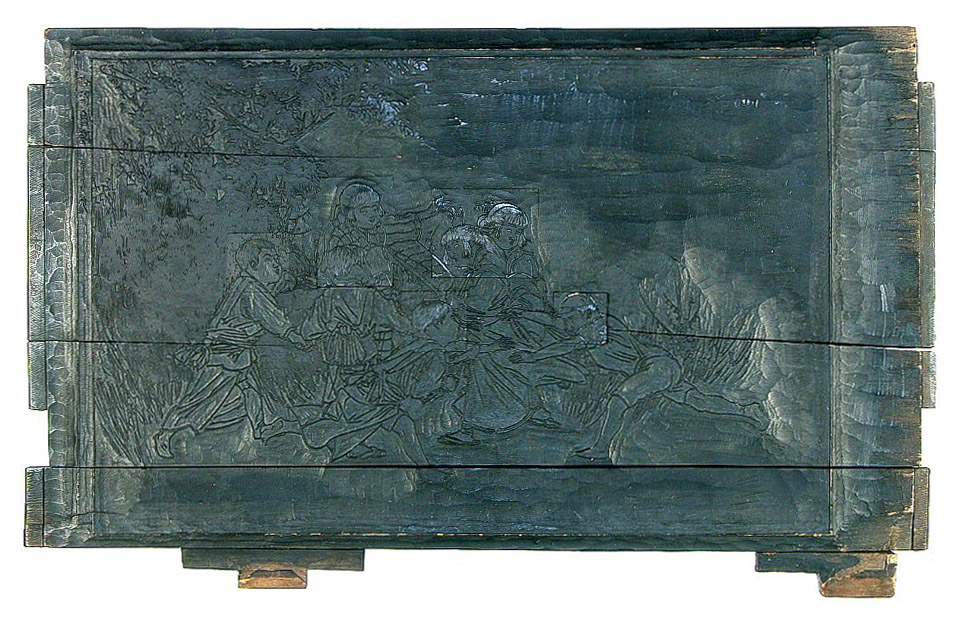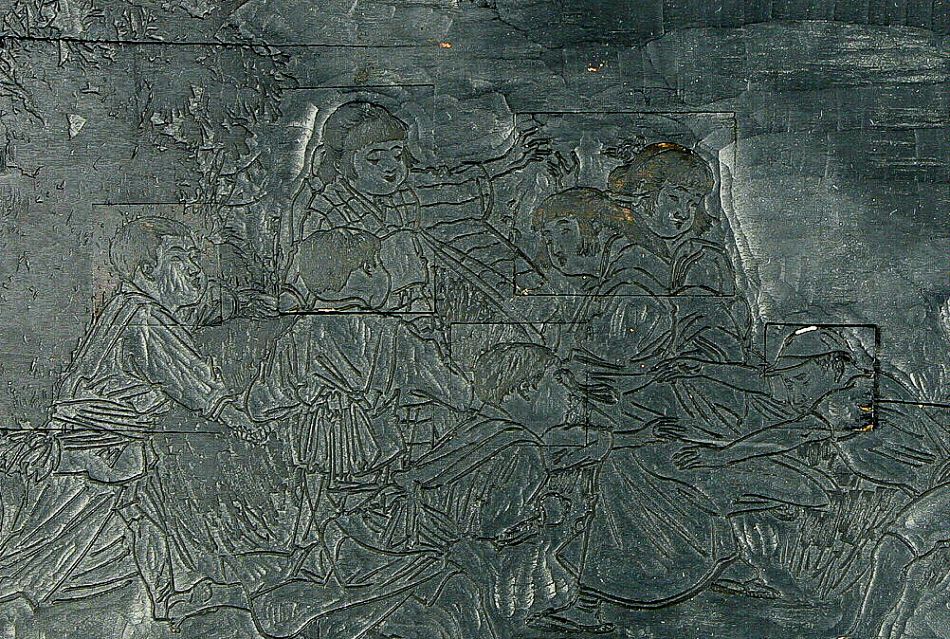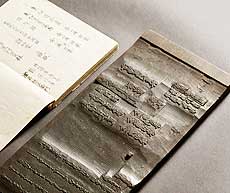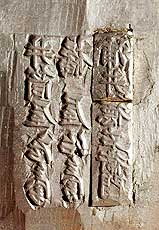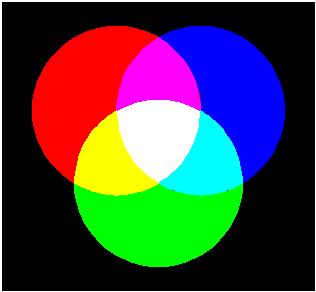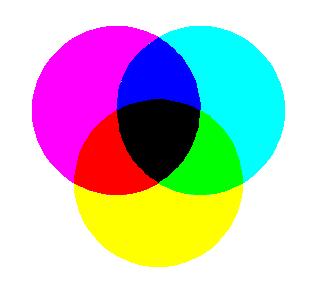Woodblock publishing
By William Wetherall
First posted 7 September 2004
Last updated 10 November 2017
History
Kawaraban
•
Hanga
•
Ukiyoe
•
Nishikie
Printing
Carving
•
Registration
•
Editing
•
Pigments
•
Washi
Publishing
How nishikie prints were published
(1) Publishers, drawers, writers, (2) Carvers and printers, (3) Official approval seals,
(4) Consumers and collectors, (5) Art and social historians, (6) Who should get credit?
History
Woodblock printing goes back at least two millennia and probably begins in China, India, and Egypt, where wood blocks were used to print images on textiles. The earliest extant woodblock publication is a Buddhist sutra, dated 868, found in a cave in Dunhuang in China. The quality of the printing is high, so the technology must have developed over a considerable period before this.
Woodblock printing was introduced to Japan from China during the Tang dynasty (630-930). Japanese drawers mastered Chinese technologies and styles then innovated their own. As in China, the earliest publications were religious texts and drawings. Later woodblock printing was used to publish secular writing and art.
The whole object of woodblock printing is mass production. They were, in this sense, the conceptual precursors of flatbed, rotary, and offset lithograph presses that use galleys of type, and carved, etched, or other plates, to make multiple prints.
Kawaraban
The oldest known woodcut in Europe dates from the 15th century. Color woodcuts appear in Europe from the 16th century. In Japan, woodblock newsprints called kawaraban were published in the early 17th century, possibly inspired by European publications.
News sheets in Japan probably go back to the late 16th century, though the earliest extant example of a kawaraban is dated 1615. Such one-off sheets were not, in fact, called kawaraban until the middle of the 19th century. The kanji used to write kawaraban mean "tile print" (瓦版), but like this is probably a folk etymology confusing a place name with a kind of earthenware. No one has ever found a kawaraban printed from a clay block. All known kawaraban have been printed from woodblocks. (Nakae 2003:70)
Hanga
Woodblock pictures in general are called hanga (版画). Color woodblock pictures called ukiyoe developed during the 17th century out of a tradition of hand-coloring. A more colorful variety of ukiyoe, called nishikie, appeared in the 18th century.
Ukiyoe
Ukiyoe (浮世絵) or "floating world pictures" are associated with the transient enjoyments and pleasures of the world of entertainment. The genre developed and flourished in Edo, hence contemporary synonyms like Edoe (Edo picture) and azumae (eastern picture). Azuma was a pronoun for Edo, since Edo was east of Kyoto. It became part of the name of Tokyo, which means "eastern capital", just as Beijing means "northern capital".
Ukiyoe typically portrayed courtesans and other beautiful women, famous kabuki actors and scenes, heroic warriors, explicit erotica called shunga (spring pictures), scenes from classical Japanese and Chinese literature, comical scenes from contemporary life, parodies of familiar stories, landscapes, and pictures of birds and flowers.
Nishikie
Nishikie (錦絵) are a particularly colorful offshoot of ukiyoe. In their manner of manufacture and thematically, they are a kind of ukiyoe.
Nishikie developed in the middle of the 18th century when ukiyoe drawers began using new pigments of brighter and more saturated colors, reminiscent of silk brocades (nishiki). Though nishikie is commonly translated "brocade pictures", such quaintness is on a par with calling washi "rice paper".
The gaudier nishikie quickly became more popular than quieter ukiyoe. By the Bakumatsu years (1853-1868), on the eve of the Meiji period (1868-1911), practically all color woodblock prints were nishikie.
Printing
A black picture requires only one block. Color pictures are printed from sets of blocks, with a block for each color or stage.
Woodblock printing, boiled down to its basics, involves (1) carving an image into a block of wood, (2) applying pigment to the ridges of wood that remain, and (3) making an impression of the pigmented ridges on cloth, paper, or any material that will accept the pigment, but typically washi.
Carving
There are two ways to carve an image into a block. Cutting away the wood on either side of a line or image leaves a ridge or surface that prints as a "black line" or positive image. Cutting away the line or image, leaving wood around it, results in printing a "white line" or negative image.
While the pictures carved on the key blocks of hanga are generally positive, some lines on the other blocks may be negative in order not to overprint a positive line. Since the pigments are transparent, overprinting any color on a black line or image will not change its blackness.
Overprinting blue on a yellow line, though, would cause the line to appear green. If this is the intent, fine. But if the line is supposed to remain yellow, then the blue block has to be cut so that the color doesn't print on the line. In other words, a negative line has to be cut into the block.
RegistrationHow to get make sure that multiple impressions in different colors were properly aligned was a major challenge. Complex nishikie prints became possible only after the development of a simple and sure method of registration. The solution to the registration problem was the use of kento (見当) guide marks. The marks consited of an L-shaped mark called a kagi (かぎ) or "key", and a straight horizontal mark called a hikitsuke (ひきつけ) or "alignment mark". Both marks were cut into, or attached to, the upper or lower edge of the key block, off the print area. The kagi was cut as a right angle in one corner, left or right, and the hikitsuke was cut in other corner. The marks were printed on the proofs that were used to make the other blocks, and were subsequently carved into every block. On the right are a full and closer view of a block of a drawing by Kobayashi Eiko (1868-1933). The full image shows an example of how registration marks could be attached to a block. Here the marks are on the bottom, with the key mark in the lower-right corner. When making an impression from a given block, the corner of the paper of the paper with the kagi mark would be anchored on the kagi mark on the block, and the hikitsuke mark on the paper would be brought into alignment with the hikitsuke mark on the block. This had to be done carefully and precisely, but with a little practice, registration was assured. See David Bull's The Traditional 'Key Block' Method for an example of registration keys and how they work. |
EditingWorn, damaged, and miscarved areas of a block could be recarved after inlaying a new piece of wood into an affected area. Inlaying a piece of wood, called ireki (入れ木), was also used proactively, as when drawing hair and other details which required a harder wood. The Eiko ireki image to the right shows inlays used for all the children's heads. In 1998, one block among a lot of some 500 wood blocks purchsed by Nara University from a Kyoto antiquarian book dealer turned out to be related to an early printing of Matsu Basho's Oku no hosomichi (The narrow road through Oku). Basho (1644-1694) died before this account of his travels with Sora through the remote northern provinces was published. Oku no hosomichi was first printed in 1702 by the Kyoto publisher Izutsuya Shobee. Izutsuya lost its blocks in a fire that burned through the city in 1788. The discovered block is related to a 1789 edition that Izutsuya co-published with Tachibanaya Jiee, who was closely affiliated with Izutsuya, hence the names of both publishers were carved on the block. Urai Tokuemon, another publisher, acquired the blocks in 1807 and inlayed his name alongside the names of the other two publishers. Elsewhere on the block Urai added the characters "Kaisendo zohan" (諧仙堂蔵板) meaning "Blocks owned by Kaisendo", the name of his publishing house. Urai had the choice of chiseling off the names of the earlier publishers. Apparently he left them because Izutsuya was still a well-known "brand" in the publishing industry. Inlaying his name to the left of the others (to the right as you look at the block) was Urai's way of showing that his edition had good ancestry. On this website, there are several examples of later editions of news nishikie printed by secondary publishers who inlaid their own name in the block -- not alongside, but in place of, the original publisher (e.g., Tsujibun in place of Gusokuya). And Tokyo nichinichi shinbun Number 851 was reissued in an altered version apparently after pressure to rewrite the story and leave out names. Such alterations were made with ireki. [ Information on the Oku no hosomichi block, and the images of the block, are from Yomiuri Shinbun, Osaka honsha, "Rekishi no katachi" kakari [Yomiuri Shimbun, Osaka headquarters, "Forms of history" section], Oku no hosomichi no hangi o miru: "Ireki" ga kataru Edo no shuppan jijo [Looking at the Okuno hosomichi woodblocks: Publishing conditions in the Edo period as told by "Ireki"], <http://osaka.yomiuri.co.jp/katati/2004/040308.htm>, posted 8 March 2004, viewed 13 September 2004. ] |
PigmentsThe principles behind color printing are fairly simple if you keep in mind what is happening between the pigment and the eye in relationship to the light used to illuminate the picture -- which we will assume is natural or "white". A piece of paper and a movie screen are both white. So why are the principles of color in movie projection and printing different? When you watch a movie projected on a white screen in a dark theater, you see colors reflect off the screen just as they have been projected, with nothing subtracted. When you look at a printed picture, illuminated by white light, the reflected colors represent what has not been absorbed -- what has not been subtracted from the light -- by the pigments. Three-color projection systems cause colors to overlap, and wherever they overlap they add. Overlapping red and green become yellow, red and blue become magenta, green and blue become cyan, and all three become white. In an additive system like a movie projector and white screen, black is achieved by not projecting any light. The absence of light on the white screen is seen as black because the room is dark. Why else did you think they turn off the lights? Printing with opaque (light-blocking) pigments means that you will see whatever color is reflected by the pigment on top. Oil paints are moderately to entirely opaque, so green paint on top of red will look green if thick enough and you don't mix it with the green. The red pigment looks red because it aborbs green and blue from the white light that illumiates it. The green looks green because it absorbs red and blue from the white light. If the red paint is still wet, and you mix the green paint with it, you will probably get a mess. If you illuminate a red square, green square, and blue square with a blue light, they red and green squares will look black, and the blue square will look blue. If you illuminate them with a yellow light, the red square will absorb the green component and reflect the red component hence look red; the green square will absorb the yellow component and reflect the green component hence look green, and the blue square will absorb both the red and green components of the yellow and so will appear black. Why is the sky blue? Because the blue component of the sun's white light scatters in the atmosphere more than the green component, which scatters more than the red component. Less red and green light are scattered, and hence the sun looks yellowish, especially when it is just rising or setting. It begins to look redder as the green component, too, is scattered away, leaving more red. Now comes the magic of transparent (light-passing) pigments. If you print a black pigment on a piece of paper, it will absorb all colors of light in the visible spectrum. It appears black because it reflects no light. If you overlay the black with an opaque pigment, the color will change to that of the opaque pigment. But no mater what color of transparent pigment you print over black, the black will still look black -- because no matter what color the transparent pigment passes (i.e., does not reflect), all the light that passes will be absorbed by the black. So what happens when you overprint a transparent yellow, say, with a transparent cyan? When you print the yellow on white paper, the yellow absorbs blue and passes red and green, which are reflected as yellow. When you overprint with cyan, the cyan absorbs red and passes green and blue, while the yellow absorbs the blue and passes the green, so the green is all that is left to reflect off the white paper. If you were to then overlay the yellow and cyan with magenta, the magenta would absorb green and pass red and blue, the cyan would absorb the red and pass the blue, and the yellow would absorb the blue. And because there would be no light left to reflect, you would see black. However, absorption and reflection qualities of pigments are imperfect. So the best way to create black is to use black ink, which in the world of nishikie meant a carbon-based pigment called sumi (墨), which means "soot" -- or refers to an ink of the "India ink" kind that is used to brush calligraphy and to draw sumie (墨絵) or "soot pictures". See David Bull's The Traditional 'Key Block' Method for an example of how both positive and negative images are cut into color blocks to create the desired combinations of colors. |
WashiPractically all publications in Japan, including nishikie, were printed on washi or "Japanese paper". Washi (widely mistranslated "rice paper") is manufactured from the long fibers of a number of plants, from mulberry to hemp. Paper making methods were introduced from China around the 7th century. Local innovations resulted in a distinction between "Japanese" and "Chinese" papers, and later "overseas" (European, western) papers. There are many kinds of washi, named after the kinds of fibers used to make them, or the places where they are made. Washi is a particulary durable paper but, like any paper, it is sensitive to heat, humidity, and other environmental agents. Freshly manufactured washi is usually not suitable for printing. It first has to be coated or "sized" with a solution made of an animal bone glue or alum, which prevents bleeding of the pigment. Immediately before use, sized washi may also have to be very slightly moistened to allow it to take the pigment, which is emusified in a water-based paste made with flour. The way the pigment binds to the paper, without bleeding, depends on proper sizing and humidification. |
Publishing
The production of nishikie and other ukiyoe was a team effort. The quality of a print was at the mercy of every member of the team. Woodblock prints are usually attributed to a drawer. Sometimes the name of the carver is given, sometimes also the publisher. But many others were involved in the laborious and demanding process of publishing a single woodblock print, including suppliers of wood, paper, and pigments.
A composer gets credit for a score. The orchestra gets credit for playing. Some conductors get more billing that either the composer or the orchestra. Only the musicians care about who made the intruments. The name of the architect who designed the concert hall is probably forgotten.
The publishers who produced news nishikie were orchestra owners and conductors. Woodblock prints could not have been made without their enterprise and leadership. Publishers oversaw the entire operation of producing a woodblock print. Drawers and craftsmen alike owed their livelihoods to the entrepreneurial and organizational skills of a publisher.
Today a woodblock drawer is likely to have to do everything -- find suitiable wood, paper, and pigments -- draw, carve, print -- even market and sell -- though with the help and cooperation of many others along the way. In the Tokugawa and early Meiji periods, drawers were drawers. Carvers were carvers. Printers were printers. Distributors were distributors. The officials who placed their seals on drawings before they were carved were bureaucrats, as were the tax collectors. The publisher orchestrated all these people, keeping some busy, others just happy, while coordinating everything. The publisher may also have owned a shop or two that sold prints, books, and other publications.
So the "quartet" that many people mention when describing the production of woodblock prints -- publisher, drawer, carver, printer -- was really a much larger ensemble of drawers, carvers, printers, copiests, understudies, and helpers, and suppliers and wholesalers, who could not have played very well, if at all, without a publisher to tell them what the score was and conduct them.
The following table is a very general overview of how a news nishikie, and most other woodblock prints at the time, came into being. The overview barely touches the surface of the complex and fascinating woodblock printing industry.
Fortunately there are some excellent and comprehensive introductions to woodblock printing technology and art on the Internet. Some links to relevant material are included in the following summaries. See the Woodblock Printing section of the Web Sources page a few other links. Many woodblock printing sites have glossaries of key words, but see the Terminology section for links to dictionaries and encyclopedias dedicated to art.
|
How nishikie prints were published |
| 1 -- Publisher collaborates with drawer and writer |
|
The publisher (hanmoto), in effect a publishing company, usually came up with an idea for a drawing or series of drawings and sought out the drawer (eshi). Drawers were free to come up with their own ideas, and the more inspired drawers were probably more active in proposing works, especially to their favorite publishers. All drawers, though, were at the mercy of the print shops and the market, both of which were the domains of the publishers. Hence their close collaboration with publishers, someones only one. They worked on a contractual basis for lump sums, and only a few enjoyed star status. In the case of news nishikie, and other nishikie that included stories (though few), the drawer collaborated with a story teller, who could be a well-known writer or orator. Several news nishikie drawers and writers are known to have collaborated on several projects over the years, for different publishers, which suggests that relationships on all fronts were cozy. |
| 2 -- Drawer and writer make preliminary drawing and draft |
|
The drawer produced a preliminary or "under" drawing (shitae), which could be very simple or elaborate. Some survive and are quite valuable. Then either the signature drawer, or an understudy or a copiest (hikko) working from the preliminary design, would produce a block drawing (hanshitae, hanshita), typically by placing the preliminary drawing under a very thin piece of paper and tracing it in black pigment. The block drawing was used for carving the key block (omohan). In the case of news nishikie, which had a story in addition to the picture, the drawer, the writer, or more likely a copiest wrote the text for the story on the block drawing, either around the picture (as in Tokyo nichinichi shinbun nishikie) or in a cartouche at the top (as in Yubin hochi shinbun nishikie). |
| 3 -- Publisher gets permission from officials |
|
The publisher submitted the block drawing to an official (gyoji) of the picture-and-literature (ezoshi) sellers guild in the jurisdiction of the town magistrate for examination (ken'etsu). The official approved the drawing by affixing an inspection seal or aratamein (改印) that was carved into the key block along with the drawing, sometimes on the margin, sometimes in the picture area. During the later half of the Tokugawa period and the first few years of the Meiji period, publishers were required to submit preliminary drawings or drafts of materials they intended to publish to an official for prior approval. The system changed several times. During the Tenpo reforms (from 1842) the town headman (nanushi), who had more authority than the guild official, approved publications. The system changed in 1853, and again in 1872. The seal-system ended after 1876, with legal reforms that required publishers to specify the year, month, and day of a publication. There were various kinds of seals, and they changed from time to time. So the seal on a woodblock work publication provides an important clue to the time it was made. During the first few years of the Meiji period, the seal was changed several times a year, and so early news nishikie that bear such seals can be roughly dated to the month. See Typical Nishikie Details for an example of a seal of approval on a news nishikie, and for a table of the seals used from Meiji 5 (1872) through Meiji 8 (1875), which covers the period of the earliest news nishikie. See J. Noel Chiappa's Date Seals and the Japanese Calendar for an overview of five periods of seal approval system from 1790 to 1872. See J. Noel Chiappa's Zodiacal Calendar Date Seals for more examples of zodiac date seals. See J. Noel Chiappa's Nanushi Censor Seals for examples of seals used between 1842 and 1853, during the period of the Tenpo reforms. |
| 4 -- Carver cuts key block |
|
A carver (horishi) pasted the preliminary drawing face down on a block of wood, typically well-cured and straight-grained cherry, and carved the drawing into the block with chisels. The block drawing was naturally destroyed in the process of carving its design into the wood. Registration marks were also carved on this block. Watch David Bull draw, cut, and print a hanga. |
| 5 -- Printer makes proofs for color and other blocks |
|
A printer inked the blocks, and using a baren, which had to be carefully broken in to press the paper evenly against the pigmented block, pulled as many black proofs (sumizuri) off the key block as were needed -- as many as ten, sometimes more, depending on how many colors or stages were anticipated. The proofs included the ever-important registration marks. |
| 6 -- Drawer designates colors and stages |
|
The drawer (designer) would indicate the areas that were to be colored. He might just mark the colors on a single proof and leave it to others to work out the color and staging details. Or he himself might work out the details himself. In the end, though, there would be a proof for each color or stage, and the areas that were to be printed would be brushed in a vermillion pigment called shu (朱). When applying the pigment, which was water-based, one had be careful not to warp the paper with moisture, because this would affect the register of that part of the image. |
| 7 -- Carver cuts other blocks |
|
The carver -- or a team of carvers working under the master carver -- engraved a separate block for each of the proofs. They would also carve the registration marks into the blocks so that, as successive impressions were made on a sheet of paper, the paper could be aligned so that the impressions would register. |
| 8 -- Printer pulls sample prints |
|
The printer produced a sample print or two, making impressions of each block in the correct succession, which had already been thought out in terms of how the colors and design elements would overlap. See J. Noel Chiappa's Production of Japanese Woodblock Prints for an example of a fourteen-block printing. See David Bull's The Traditional 'Key Block' Method for an an example of a how a few colors are combined to make more colors. |
| 9 -- First printing made with approval of samples |
|
When the drawer and possibly also the writer approved the sample print, the first printing (shozuri) was made, typically around 200 copies. This was about all the blocks could take they would need to be cleaned. |
| 10 -- Publisher submits copy to officials and pays fees and taxes |
|
The publisher submitted a copy of the first printing to the official who had approved publication, paid a fee to the offical, and also paid a publication tax. |
| 11 -- Prints are sold at shops and hawked on streets |
|
The prints were sold at picture-and-literature shops (ezoshiya), some of them most likely owned by the publisher. They were also hawed by street vendors. Copies of some prints were distributed to sellers in towns in the provinces. |
| 12 -- People buy prints mostly as mementoes and souvenirs |
|
People bought prints for themselves and to give others. They bought them for the same reasons people today buy art and posters. They made great mementoes and souvenirs. They relieved bordom. They decorated walls. They satisfied needs to admire beautiful courtesans and handsome actors, and brave heroes and heroines. |
| 13 -- Blocks washed and dried for further printings |
|
The blocks had to be washed and dried before another printing could be made. This was a critical process that, if done incorrectly, could cause the blocks to warp, which could throw off registration and other qualities of the impression. The blocks also wore as more impressions were made, so later printings were almost always inferior to earlier printings. Later editions might involve different batches of pigment, so colors could vary. Blocks might even be recarved to accommodate high demand. |
| 14 -- Blocks sold to other publisher |
|
The original publisher was free to sell the blocks to another publisher, for the blocks belonged to the publisher, not the drawer or the writer. Among the news nishikie shown on this site are several examples of editions that were printed by secondary publishers. Block ownership was designated by the term "zohan" (蔵版). The term could refer to the blocks themselves (as being in the custody of a certain publisher), or to the publication rights associated with the blocks. A similar expression is still used in ex libris stamps, as in "Yosha zosho" (羊舎蔵書), meaning "From the library of Yosha". Yours truly. If you find a book that has this stamp, it's mine. Or it used to be mine. |
| 15 -- Blocks recycled or stored and forgotten |
|
What happened to blocks that had served their purpose? I really don't know. Were thicker blocks planed down and reused? Were they recycled for use in wood products? Or split and burned for heat? Very few have survived. The discovery of a set of blocks in the storage shed of an old home is almost always big news. |
| 16 -- Collection industry develops as older prints become valued |
|
While there has always been some interest in older prints (if not, then older prints would never have survived), this interest spreads as older prints become more widely viewed as having artistic and/or historical value. This tranlates into commercial value, and so shops and dealers specializing in older prints increase, as do people with knowledge and kills that enable them to preserve or restore prints, or authenticate and apppraise them. Scholars who study prints in terms of art or social history increase. Prints are featured in museum exhibitions and in books and other media about art or history. Websites about prints multiply like rabbits. |
| 17 -- People debate who should get artistic credit |
|
The earth quakes with controversy over who should get credit for the art. Sometimes the drawer sketched only a rough outline of a drawing and left the details to others. The same problem arises when trying to determine who actually drew certain works attributed to a European master or other drawer known to have signed pieces done partly or wholly by understudies. See J. Noel Chiappa's Production of Japanese Woodblock Prints for a more detailed discussion of publishers and drawers, carvers, and printers, and their relationships. See Japanese Traditional Prints - Just who 'made' them anyway? for a very interesting discussion between David Bull and others on the question of who deserves credit for what. |
